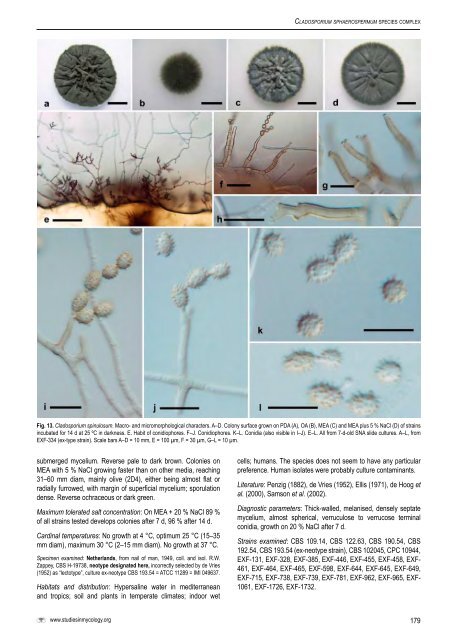The genus Cladosporium and similar dematiaceous ... - CBS - KNAW
The genus Cladosporium and similar dematiaceous ... - CBS - KNAW
The genus Cladosporium and similar dematiaceous ... - CBS - KNAW
Create successful ePaper yourself
Turn your PDF publications into a flip-book with our unique Google optimized e-Paper software.
<strong>Cladosporium</strong> sphaerospermum species complex<br />
Fig. 13. <strong>Cladosporium</strong> spinulosum. Macro- <strong>and</strong> micromorphological characters. A–D. Colony surface grown on PDA (A), OA (B), MEA (C) <strong>and</strong> MEA plus 5 % NaCl (D) of strains<br />
incubated for 14 d at 25 ºC in darkness. E. Habit of conidiophores. F–J. Conidiophores. K–L. Conidia (also visible in I–J). E–L. All from 7-d-old SNA slide cultures. A–L, from<br />
EXF-334 (ex-type strain). Scale bars A–D = 10 mm, E = 100 µm, F = 30 µm, G–L = 10 µm.<br />
submerged mycelium. Reverse pale to dark brown. Colonies on<br />
MEA with 5 % NaCl growing faster than on other media, reaching<br />
31–60 mm diam, mainly olive (2D4), either being almost flat or<br />
radially furrowed, with margin of superficial mycelium; sporulation<br />
dense. Reverse ochraceous or dark green.<br />
Maximum tolerated salt concentration: On MEA + 20 % NaCl 89 %<br />
of all strains tested develops colonies after 7 d, 96 % after 14 d.<br />
Cardinal temperatures: No growth at 4 °C, optimum 25 °C (15–35<br />
mm diam), maximum 30 °C (2–15 mm diam). No growth at 37 °C.<br />
Specimen examined: Netherl<strong>and</strong>s, from nail of man, 1949, coll. <strong>and</strong> isol. R.W.<br />
Zappey, <strong>CBS</strong> H-19738, neotype designated here, incorrectly selected by de Vries<br />
(1952) as “lectotype”, culture ex-neotype <strong>CBS</strong> 193.54 = ATCC 11289 = IMI 049637.<br />
Habitats <strong>and</strong> distribution: Hypersaline water in mediterranean<br />
<strong>and</strong> tropics; soil <strong>and</strong> plants in temperate climates; indoor wet<br />
cells; humans. <strong>The</strong> species does not seem to have any particular<br />
preference. Human isolates were probably culture contaminants.<br />
Literature: Penzig (1882), de Vries (1952), Ellis (1971), de Hoog et<br />
al. (2000), Samson et al. (2002).<br />
Diagnostic parameters: Thick-walled, melanised, densely septate<br />
mycelium, almost spherical, verruculose to verrucose terminal<br />
conidia, growth on 20 % NaCl after 7 d.<br />
Strains examined: <strong>CBS</strong> 109.14, <strong>CBS</strong> 122.63, <strong>CBS</strong> 190.54, <strong>CBS</strong><br />
192.54, <strong>CBS</strong> 193.54 (ex-neotype strain), <strong>CBS</strong> 102045, CPC 10944,<br />
EXF-131, EXF-328, EXF-385, EXF-446, EXF-455, EXF-458, EXF-<br />
461, EXF-464, EXF-465, EXF-598, EXF-644, EXF-645, EXF-649,<br />
EXF-715, EXF-738, EXF-739, EXF-781, EXF-962, EXF-965, EXF-<br />
1061, EXF-1726, EXF-1732.<br />
www.studiesinmycology.org<br />
179

















